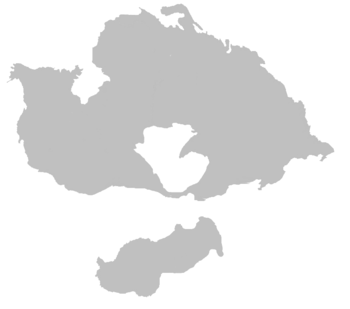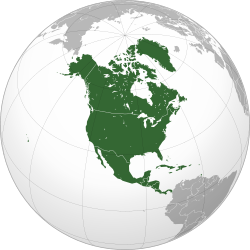Pangaea Proxima
Pangaea Proxima (also called Pangaea Ultima, Neopangaea, and Pangaea II) is a possible future supercontinent configuration. Consistent with the supercontinent cycle, Pangaea Proxima could occur within the next 300 million years. This potential configuration, hypothesized by Christopher Scotese, earned its name from its similarity to the previous Pangaea supercontinent. Scotese later changed Pangaea Ultima (Last Pangaea) to Pangaea Proxima (Next Pangaea) to alleviate confusion about the name Pangaea Ultima which could imply that it would be the last supercontinent.[1] The concept was based on examination of past cycles of formation and breakup of supercontinents, not on current understanding of the mechanisms of tectonic change, which are too imprecise to project that far into the future. "It's all pretty much fantasy to start with," Scotese has said. "But it's a fun exercise to think about what might happen. And you can only do it if you have a really clear idea of why things happen in the first place."[2]

Supercontinents describe the merger of all, or nearly all, of Earth's landmass into a single contiguous continent. In the Pangaea Proxima scenario, subduction at the western Atlantic, east of the Americas, leads to the subduction of the Atlantic mid-ocean ridge followed by subduction destroying the Atlantic and Indian basin, causing the Atlantic and Indian Oceans to close, bringing the Americas back together with Africa and Europe. As with most supercontinents, the interior of Pangaea Proxima would probably become a semi-arid desert prone to extreme temperatures.[3]
Formation
According to the Pangaea Proxima hypothesis, the Atlantic and Indian Oceans will continue to get wider until new subduction zones bring the continents back together, forming a future Pangaea. Most continents and microcontinents are predicted to collide with Eurasia, just as they did when most continents collided with Laurentia.[4]
Around 50 million years from now, North America is predicted to shift west and Eurasia would shift to the east, and possibly even to the south, bringing Great Britain closer to the North Pole and Siberia southward towards warm, subtropical latitudes. Africa is predicted to collide with Europe and Arabia, closing the Mediterranean Sea (completely closing the Tethys Ocean (or Neotethys) and the Red Sea) and forming a supercontinent called Afro-Eurasia. A long mountain range (the Mediterranean Mountain Range) would then extend from Iberia, across Southern Europe and into Asia. Some are even predicted to have peaks higher than Mount Everest. Similarly, Australia is predicted to beach itself past the doorstep of Southeast Asia, causing the islands to be compressed inland, forming another potential mountain range, and forming a supercontinent, called Afro-Euraustralasia. Meanwhile, Southern and Baja California are predicted to have already collided with Alaska with new mountain ranges formed between them.[5]
About 125 million years from now, the Atlantic Ocean is predicted to stop widening and begin to shrink because some of the Mid-Atlantic Ridge will have been subducted. In this scenario, a mid-ocean ridge between South America and Africa will probably be subducted first; the Atlantic Ocean is predicted to have narrowed as a result of subduction beneath the Americas. The Indian Ocean is also predicted to be smaller due to northward subduction of oceanic crust into the Central Indian trench. Antarctica is expected to shift northwards, colliding with Madagascar and Australia, enclosing a remnant of the Indian Ocean (called the Indo-Atlantic Ocean), and creating the supercontinent Terra Orientalis.[6]
When the last of the Mid-Atlantic Ridge is subducted beneath the Americas, the Atlantic Ocean is predicted to close rapidly.[7]
At 200 million years in the future, the Atlantic is predicted to have closed. North America is predicted to have already collided with Africa, but be in a more southerly position than where it drifted. South America is predicted to be wrapped around the southern tip of Africa, completely enclosing the Indo-Atlantic Ocean. The Pacific Ocean will have grown wider, encircling half the Earth.[7]
Other suggested supercontinents
Paleogeologist Ronald Blakey has described the next 15 to 85 million years of tectonic development as fairly settled and predictable, without supercontinent formation.[8] Beyond that, he cautions that the geologic record is full of unexpected shifts in tectonic activity that make further projections "very, very speculative".[8] In addition to Pangaea Proxima, two other hypothetical supercontinents—"Amasia" and "Novopangaea"—were illustrated in an October 2007 New Scientist article.[9]
References
- Willams, Caroline; Nield, Ted (2007). "Earth's next supercontinent". New Scientist. 196 (2626): 36–40. doi:10.1016/S0262-4079(07)62661-X.
- "Continents in collision: Pangaea Ultima". NASA Science News. October 6, 2000.
- Kargel, Jeffrey S. (2004). "New World". Mars: a warmer, wetter planet. Springer. ISBN 978-1-85233-568-7.
- Broad, William J. (January 9, 2007). "Long-Term Global Forecast? Fewer Continents". The New York Times.
- "Our globe in next 50 million years". Volcano World. Oregon State University. Archived from the original on 2009-04-05.
- Scotese, Christopher R. "The Atlantic Ocean begins to Close". Paleomap Project. Retrieved 2012-03-24.
- Scotese, Christopher R. ""Pangea Ultima" will form 250 million years in the Future". Paleomap Project. Retrieved 2006-03-13.
- Manaugh, Geoff; Twilley, Nicola (23 September 2013). "What Did the Continents Look Like Millions of Years Ago?". The Atlantic. Retrieved 2014-07-22.
- Williams, Caroline; Nield, Ted (2007-10-20). "Pangaea, the comeback". NewScientist. Retrieved 2009-08-28.
Further reading
- Nield, Ted, Supercontinent: Ten Billion Years in the Life of Our Planet, Harvard University Press, 2009, ISBN 978-0674032453
.svg.png)
.svg.png)
.svg.png)
.svg.png)


.svg.png)
_political.svg.png)
.svg.png)
.svg.png)
.svg.png)